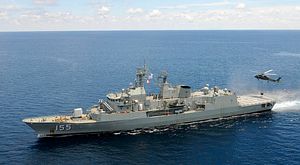This week Australian vessels docked in Malaysia’s Port Klang for a goodwill visit. The interaction put the spotlight on both the Australia-Malaysia defense relationship as well as Canberra’s defense role in the region more broadly, already in the spotlight with one of the largest coordinated task group deployments seen in decades.
On September 4, a fleet of six RAN ships got underway from Sydney for the start of Indo-Pacific Endeavor 2017, dubbed the largest coordinated Australian task group deployment since the early 1980s. More than 1,200 Australian Defense Force personnel are currently participating engagements across several Asian states – Brunei, Cambodia, Micronesia, India, Indonesia, Japan, Malaysia, the Philippines, South Korea, Singapore, Thailand and East Timor. They are being led by Canberra-class amphibious ship HMAS Adelaide, which will be joined at various stages by frigates HMAS Melbourne, HMAS Darwin, HMAS Toowoomba, HMAS Parramatta, and replenishment ship HMAS Sirius.
Though the exercise is a clear demonstration of Australia’s defense role in the region more generally – with the Joint Task Group showcasing capabilities across the full spectrum of military operations including high-end capabilities like anti-submarine warfare – the framing by Australian defense officials has been focused on benign aspects of security cooperation such as humanitarian assistance and disaster relief (HADR) and building personal relationships. This is in stark contrast to the boogeyman picture painted by some Chinese state media of Australia looking to encircle Beijing.
The spotlight has shifted across specific regional states as Indo-Pacific Endeavor moves through its deployment. For instance, in East Timor last week, Australian vessels marked the anniversary of the Royal Australian Navy Task Force arrival for Operation INTERFET in 1999.
This week, the Australian vessels docked in Port Klang in Malaysia, where they will be until October 5. The occasion comes as both sides commemorate 25 years of the Malaysia-Australia Joint Defense Program (MAJDP), the framework which underpins bilateral defense interactions which include exercises, training, and professional exchanges. Malaysia and Australia are also both part of the 1971 Five Power Defense Relationship (FPDA), and both countries elevated relations to a strategic partnership back in November 2015 (See: “Malaysia, Australia Talk Terror Amid Rising Islamic State Threat”).
Other commemorative activities have gone on this year, along with more routine developments in the defense relationship. In late September, FPDA nations had just launched the third iteration of Exercise Suman Protector (“Suman” is an acronym developed from the names of all five FPDA nations), a complex, multi-level command post exercise. Also last month, Australian and Malaysian armies participated in the Haringgaroo Exercises, one of a series of bilateral exercises both sides have across their services including Mastex on the Navy side and Pitch Black on the Air Force side.
During this goodwill visit by Australian vessels, there will be a series of engagements, including an HADR exercise and demonstration on October 4 involving around 100 personnel, Malaysian media outlets reported. Following this, they will move on to a few more scheduled stops around the region before Indo-Pacific Endeavor 2017 officially ends on November 26.
































